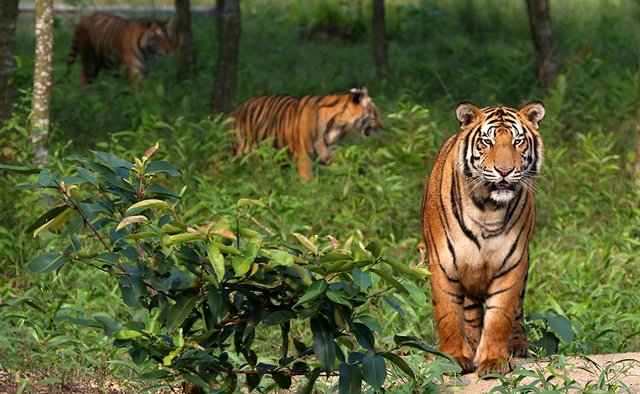Tiger census in Sundarbans to confirm population by 2019

It will take two years to determine the exact number of Royal Bengal Tigers living in the Bangladesh part of the Sundarbans, according to officials conducting a census in the country’s lone natural tiger habitat.
The Forest Department is conducting the census in collaboration with WildTeam, an NGO working for tiger conservation in the country, under the Bengal Tiger Conservation Activity project funded by the USAID.
The census, which began in November last year, is using camera trapping methodology to determine the overall tiger population in the world’s largest mangrove forest, of which around 60% lies within Bangladesh.The most recent census which concluded in 2015 recorded a tiger population of only 106 in the Bangladeshi Sundarbans, down from 440 in 2004. Project officials will want to know if this number has held up, or fallen further.
Data collection for the current census has already been completed in the Satkhira range of the mangrove forest and will be extended to the Khulna, Sharankhola and Chandpai ranges by 2019.
Sources familiar with the project said the primary monitoring and count using the cameras in Satkhira began on December 1 and ended on March 15. A total of 45 officials and experts divided into six teams conducted the survey to determine the tiger population in Satkhira range.
In addition to recording tiger numbers, the project is also tracking their population density, movement and activity.
“We set up 804 cameras at 402 stations in the range to collect data of tiger movement and density in the area,” said Md Sayed Ali, divisional forest officer at the Sundarbans West Zone. “Each camera takes a photo every 5-10 seconds.”
Using photos taken by the cameras, the population in Satkhira range will be determined by analysing the stripes on the tigers – each tiger has its own unique set of stripes, similar to fingerprints for humans.
“We will have the accurate number of tigers in Satkhira by September,” Sayed added.
Besides the camera trapping method, the team has also surveyed tiger activity in the canals.
Amir Hossain Chowdhury, director of the census project, said: “The photos are being analysed using the latest technologies. Once the analysis is done, we will get an idea about the population density and footprints of tigers in Satkhira range.”
Once the census in Satkhira is complete, the project will progress to survey the other three ranges of the Sundarbans, he added.
“It might take two more years to complete the survey in the entire Sundarbans and find the exact number of tigers in the forest,” Amir said.
The Forest Department has undertaken the project following the declaration at the International Tiger Forum which took place in St Petersburg, Russia in 2010.
According to the Wildlife Management and Nature Conservation Division, the previous census began in November 2013 and ended in 2015, also using a camera trapping method.
At that time, the census covered just the areas with high population density, which amounted to only 26% of the 6,017 square kilometres of the mangrove forest inside Bangladesh.
Thirty officials conducted the census using photos collected by 90 cameras, and recorded only 106 tigers living in the Sundarbans.
The population was 453 in 1982 and 440 in 2004, according to the Forest Department. It attributed the massive drop in numbers in just a decade to illegal poaching of wildlife and increasing human-tiger conflict.
At least 49 tigers were killed between 2001 and 2014, while 232 people were killed in tiger-human conflict during the same period, an official of the Forest Department said.
The Royal Bengal Tiger has been listed as “endangered” on the IUCN Red List of Threatened Species since 2010.
Hi! I am a robot. I just upvoted you! I found similar content that readers might be interested in:
https://www.dhakatribune.com/bangladesh/environment/2017/07/28/sundarbans-tiger-population-2019/